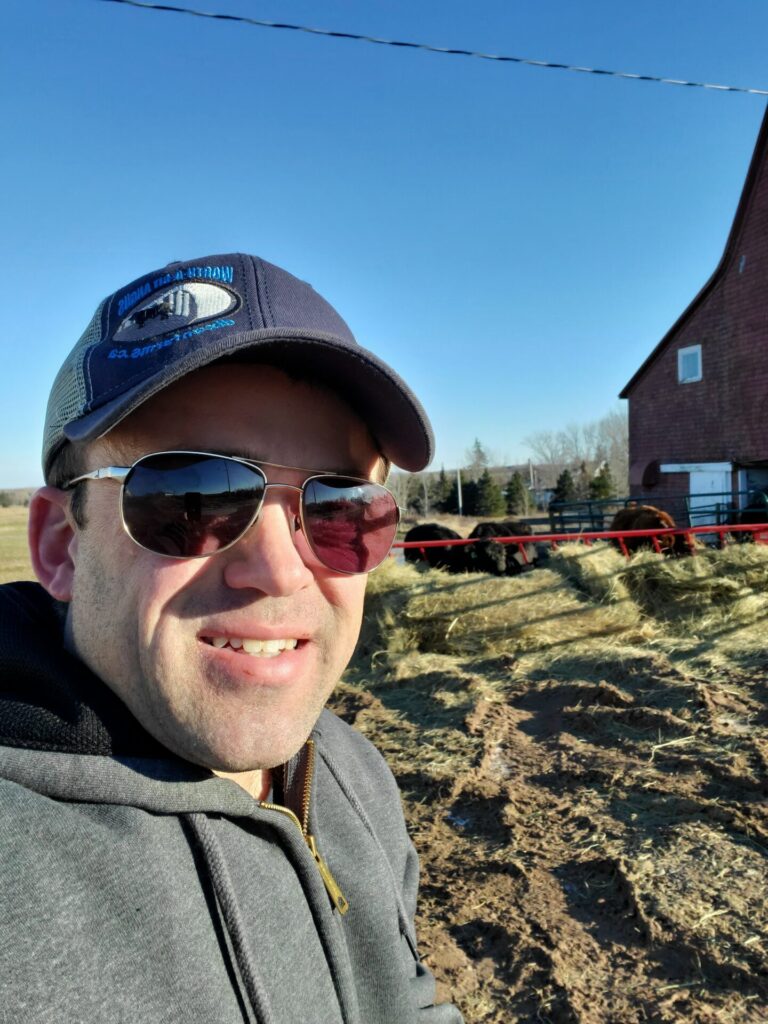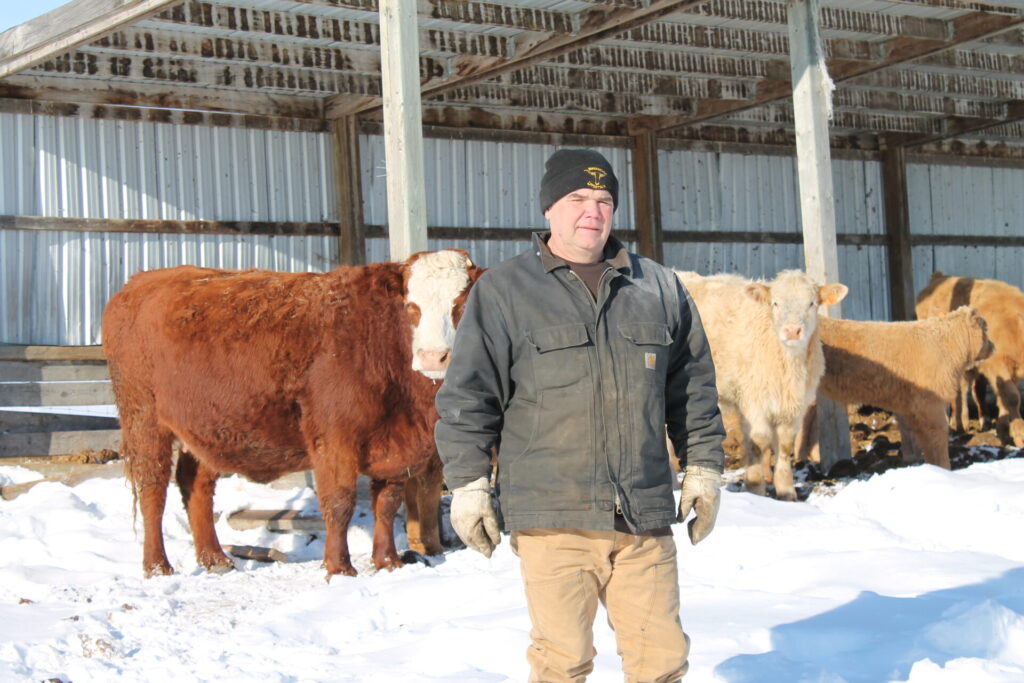How (and Why) These Eastern Canadian Cow-Calf Producers Changed and Defined Their Calving Periods 🎙️
CLICK THE PLAY BUTTON TO LISTEN TO THIS POST:
Listen to more episodes on BeefResearch.ca, Spotify, Apple Podcasts, Amazon Music or Podbean.
There are many interconnected variables that affect, or are affected by, calving season. Considerations such as infrastructure and facilities to remove and house bulls following a defined breeding season, herd size, regional market prices, targeted weaning time and labour availability are a few factors that impact a calving period.
These producers did their homework and planned ahead before shifting their calving seasons in order to meet the needs of their particular farms and families.
Spencer Yeo, Nova Scotia – Shorten Calving Period from Twelve to Six Weeks

Six years ago, Spencer Yeo who now farms in Nova Scotia had a large calving window, with the bull in year-round. About 60% of his herd calved during a 12-week timeframe but there were always stragglers which meant a lot of extra nights checking cows. Yeo had a small herd and was selling calves direct from the farmyard. With a mix of weights and smaller calves pulling the average price down, he saw an opportunity for change.
Yeo aimed to transition to a six-week calving period to help with time management as he also works off-farm full-time. He chose to aim for February calving because it is typically a little warmer then, in his region. It is also a time of year when he has the most free-time and when the majority of his cows were already calving so he was working with the herd versus against them.
The transition occurred within a single year with the breeding season shortened to May 1 through mid-June. Preg checking occurred in August, and any open females were sold. This worked well as cull cow prices were seasonally higher in August versus later in the fall, which resulted in extra income. Bull management includes the option of leasing out for a few months or selling after the breeding season. Yeo replaces the bull every two years, so only has to deal with a bull in the off-season every other year.
Considerations
There were concerns about having a significant number of open females in the transition year. Surprisingly, conception rate was high. Leading up to breeding season, the cows were on a high plane of nutrition to support conception. Spencer noted, “If you are going to adjust your calving window, you need to make sure your cows are in good shape to do it successfully.”
Infrastructure is another important consideration. In Nova Scotia, snow and freezing rain is common. Producers need to have a bedding pack under a roof, and space may be a limiting factor. Spencer had the facilities to do this but recognizes others might not choose a February calving window based on existing facilities.
The Benefits
In moving to a six-week calving season, Spencer noted it was relatively easy to identify cows that weren’t pulling their weight. With the goal of having a cow calve every 12 months, versus every 14 months or longer, it became very evident which females were meeting that objective. With a longer calving season it is harder to identify those cows that are not generating the same income as the rest. Also, with the tight calving window, Yeo has a more uniform group of calves at sale time, making it less likely to be docked on price.
From a labour standpoint, calving at Yeo’s farm is now an intense six weeks, but then it is done. Yeo notes that this provides the opportunity for vacations and time away from the farm as he is no longer staying home waiting for that one last cow to calve. Recognizing that quality of life is important, he also says there are no more late-night barn checks.
Overall, the transition to a shortened calving period has accomplished everything that he set out to do. Spencer encourages producers to keep an open mind. This includes taking a look at where they are now to see if adjusting their calving window is something that could work for them.
Donald Badour, Ontario – A Shift from Winter to Fall Calving

Almost a decade ago, Donald Badour and his family were calving from January 1 through February with a tight 60-day calving window, based on a March 20 to mid-May breeding season. Family labour was available which meant regular checks could be done throughout the day and night. As labour availability decreased and the opportunity to purchase another farm came up, the family decided to switch to fall calving from August 20 to the end of September with the breeding season starting November 14. The calving window stayed the same at 60 days.
The Badours had originally planned to shift the herd in thirds, holding back breeding of one-third of the herd for six months to result in the whole herd shifted over three years. After the first year, they realized fall calving was much easier. They did not have enough labour for two calving seasons, so they switched the rest of the herd in year two.
Their cows were always wintered outside with access to shelter, and that has remained the same. This is one of the driving reasons why they aim to be finished calving by the end of September. Calves that are any younger are much harder to manage through the winter. Their calves overwinter well in this management system and are an example that wintering calves outside in this region is possible.
The Benefits
The Badours’ main motivation for switching their calving season was to reduce labour. While winter calving, they were doing night checks and that workload has been eliminated with fall calving. Donald says, “You couldn’t pay me to go back to winter calving. It has been so much easier. Labour-wise, we went from checking every two hours to checking once per day and twice a day on heifers.”
Herd health overall has improved since the transition. Weather fluctuations with January calving often resulted in increased calf illness and higher treatment rates. In the 15 years since switching to fall calving, there have been no incidences of scours in the herd.
Any Change Requires Some Adjustments
During the first couple of years following transition to fall calving, lower conception rates made the Badours realize that they needed to change their winter feeding practices. With January calves, sold mid-September, they had utilized low-quality hay going into the fall. That was no longer feasible as they recognized the need to provide good-quality feed during breeding season, which had shifted to mid-November. It took some alterations and it was a bigger adjustment for older cows, while the younger females adapted to the change more easily. Overall, it took three years before they were happy with the performance.
Calving difficulties were reduced, as cows calving on pasture were in good body condition. However, if there was a difficulty it became a challenge due to a lack of pasture handling facilities.
Management of pastures became a consideration as well. This ended up being well-timed with the purchase of land that included more open fields (less rough ground and bush) allowing easier monitoring of cows and processing of newborn calves every day. Since calving on pasture, predators have been more of an issue. This adds to the increased need for closer monitoring of newborns.
Costs and Profitability
Fall calving has resulted in increased feed consumption (12-13 bales per cow) as compared to winter calving (10 bales per cow). This increase is due to peak lactation occurring during the winter months rather than in spring and early summer when cows are grazing. Over the last year, Badour found corn silage supported more production for fall calving cows when lactating through the winter months. Weaning weights were 52 pounds heavier, and cows came through the production cycle in very good body condition.
One major change for this operation was developing new relationships and finding buyers in a different market selling slightly younger calves during the first week of May. However, prices are seasonally strong in that time period. While weaning weights were down in first year, returns per calf were greater due to the higher price per pound. Calves are currently selling at 550 pounds, and Badour is very happy with the result.
Visit BCRC’s new Calving Seasons webpage for more information.
Sharing or reprinting BCRC posts is welcome and encouraged. Please credit the Beef Cattle Research Council, provide the website address, www.BeefResearch.ca, and let us know you have chosen to share the article by emailing us at [email protected].
Your questions, comments and suggestions are welcome. Contact us directly or spark a public discussion by posting your thoughts below.